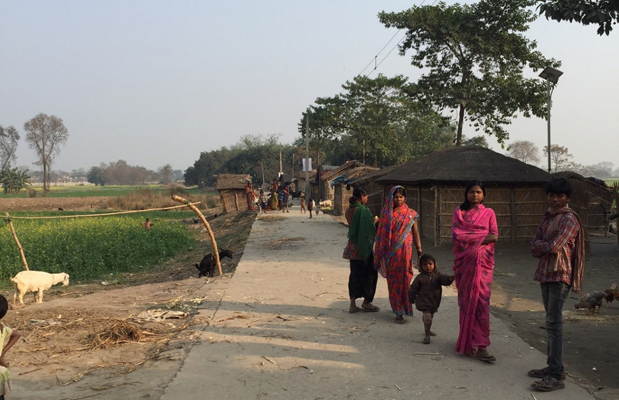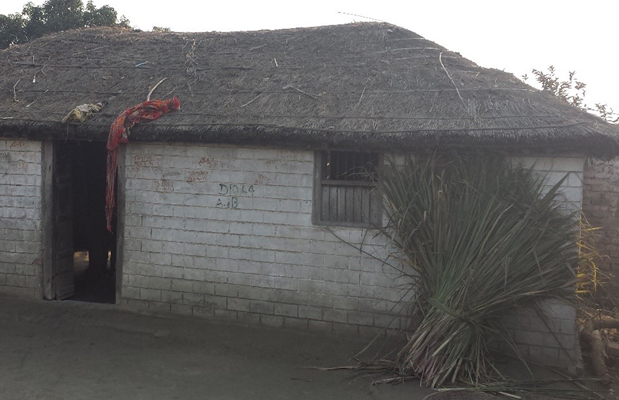By Amina Maharjan and Giovanna Gioli, ICIMOD
 Chharki village is full of Kachchi huts. (Photo: Giovanna Gioli)
Chharki village is full of Kachchi huts. (Photo: Giovanna Gioli)
There is very little stability to be found in Chharki, a small revenue village in Western Champaran, Bihar, India. As a village of displaced people who have built themselves a community within the embankments of the Gandaki River, it exists at the mercy of the river that also nourishes its land, makes habitation and sustenance possible for its people.
Bijay Mallah and his family live in this Bihari village of little means. Bijay’s father, mother, his two elder brothers, their wives and children, and his younger brother all live together in one of only three pukka houses to be found in Chharki. His three sisters have married and gone on to live with their husbands’ families outside the Gandaki embankment. Bijay dreams of a day when his entire family might leave Chharki and its entrapments behind. He has a brother-in-law who works as an auto mechanic in Saudi Arabia. He plans on joining his brother-in-law there by April 2016.
Like most others in the village, Bijay’s family relies on agriculture and wage labour for sustenance. Bijay’s elder brothers work outside Bihar (one works in Delhi and the other in Punjab). Bijay works as auto mechanic in a workshop in Bettiah, a nearby market, while his parents and younger brother are all involved in agriculture. All their incomes are collectively held by Bijay’s father, the head of the family. As agricultural income is never certain in a village where floods are very real concerns, other livelihood options are crucial in helping maintain, sustain and improve the basic livelihoods of inhabitants.
 One of the only three Pukka houses in the village. (Photo: Amina Maharjan)
One of the only three Pukka houses in the village. (Photo: Amina Maharjan)
Circular labour migration is a prominent feature of Chharki. Every year, the male members of a majority of the village’s households travel to places like Punjab and Haryana to work as agricultural labours. Such internal migration, in particular, seems to be directly related to land holding in the village. There seems to be a correlation between limited land holding and the probability of having to resorting to labour migration here.
Migration, nevertheless, helps not only increase incomes, but also increase capital accumulation and livelihood diversification. Remittances have helped many households to add to their asset base, including agricultural land. A more efficient use of human resource by increasing the villagers’ vocational and life skills will be the most efficient and effective way for improving local livelihoods.
It took Bijay a year to learn the skills of an auto mechanic. Had there been an intense and concentrated learning package available, he could have learnt the same skills in much shorter duration. Also, Bijay is lucky as he is not married and his brothers are all working as well. There is less pressure on him to earn money. Many others in the village are not so lucky as to have the luxury of learning skills at the expense of their incomes. The pressure to earn and support their families is too intense. Under such economic strains most villagers are forced to work as low-wage labourers in nearby markets or outside Bihar. If there were a programme supported by government or non-government organisations to facilitate skill development, many other villagers like Bijay could dream of getting their own households and families out of the entrapments that life in Chharki represents.
Bijay’s decision to go to Saudi Arabia is one that has not been taken overnight. Bijay has been preparing for his journey for a number of years. His educational prospects were cut short when, upon passing his fifth grade exams, he found he could no longer go to school because the nearest one that offered further education was at a distance of three kilometres from his village. It was then that he began planning an alternate career path for himself, and with his brother-in-law as his role model, Bijay started working as a low-skilled worker at an auto mechanic workshop in Bettiah. It took him a year to learn the necessary skills during which time he earned a salary of INR 1500 per month. Since then, he’s mastered the tricks of the trade and now earns around INR 15,000 per month.
Bijay’s saving for his dream job. His migration to Saudi Arabia, where he’ll join his brother-in-law will cost somewhere between INR 20,000 to INR 30,000. If all goes ahead as planned, Bijay will embark on his dream mission this year. He plans on earning and saving enough money to be able to return to Bihar and open his own auto mechanic workshop in Bettiah. To him, this dream represents a means by which to free his family from the entrapments of life inside the Gandaki embankment
Related blog by the same authors:
The Bihar Paradox: Floating Villages, Floating Lives
